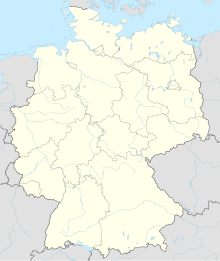Niederhagen concentration camp
Niederhagen concentration camp in Germany
|
The Niederhagen concentration camp was a temporary National Socialist concentration camp on the outskirts of Büren - Wewelsburg . It was created in 1941 from the Wewelsburg satellite camp , a subcamp of the Sachsenhausen concentration camp .
description
Since 1939, the Reichsführer SS Heinrich Himmler used concentration camp prisoners to renovate the Wewelsburg Castle . According to Himmler's ideas, after the “ final victory ”, the Wewelsburg should become the center of the world . Prisoners from Sachsenhausen concentration camp were sent to the Wewelsburg external command . The SS also used the concentration camp prisoners as slave labor in the construction of the driver's cabin I , the villa of the architect Hermann Bartels , in the forest settlement, in road construction and in the quarry .
The working group, which initially worked as a field command , was exposed to the weather conditions without protection. Therefore, a protective custody camp was finally built in Niederhagen, called the Wewelsburg satellite camp . More prisoners were sent to the new camp. In 1941 the SS declared this camp, which still belonged to the Sachsenhausen concentration camp and numbered around 480 prisoners, to be an independent concentration camp.
The approximately 3,900 prisoners included Jehovah's Witnesses (so-called Bible Students), political prisoners , Roma , homosexuals , Jews , prisoners of war and forced laborers from Poland , the Soviet Union , Czechoslovakia , France , the Netherlands and Belgium . Almost a third of them did not survive imprisonment.
"I am the Lord God of Wewelsburg"
"When I laugh, the devil laughs"
The death of 1,285 prisoners is proven. They died of hunger, cold, disease and the consequences of abuse. In 1942 an in-house crematorium was built.
The Gestapo also used the concentration camp as an execution site . 56 people were murdered, 42 of them by hanging and 14 Soviet prisoners of war by shooting.
From September 1, 1941 to May 1, 1943, the camp was independent. Before that, it was subordinated to the Sachsenhausen concentration camp as a satellite camp and then to the Buchenwald concentration camp as a satellite camp . From 1943 onwards there were only about 50 prisoners in the camp; on April 2, 1945, the prisoners were liberated by soldiers of the 3rd US Army .
Little is left of the camp. The fire station of the volunteer fire brigade and apartments are housed in the former camp kitchen . Today the gatehouse is used as a two-family house, on the remaining area there is a housing estate. There is now a triangular memorial at the site of the former roll call square, this is intended to remind of the triangular patches on the clothing of the former prisoners.
literature
- Wolfgang Benz , Barbara Distel (ed.): The place of terror . History of the National Socialist Concentration Camps . Volume 7: Wewelsburg, Majdanek, Arbeitsdorf, Herzogenbusch (Vught), Bergen-Belsen, Mittelbau-Dora . CH Beck, Munich 2008, ISBN 978-3-406-52967-2
- Karl Hüser, Wulff E. Brebeck: Wewelsburg 1933–1945. The concentration camp . Revision: Kirsten John-Stucke. 4th edition. Münster: Westfälisches Landesmedienzentrum 2002. (= series: Documents of Contemporary History, Issue 5)
- Kirsten John-Stucke: Sinti and Roma in the Niederhagen / Wewelsburg concentration camp (Büren-Wewelsburg), in: Karola Fings / Ulrich Friedrich Opfermann (ed.), Gypsy persecution in the Rhineland and Westphalia. 1933-1945. History, processing and memory, Paderborn 2012, pp. 101–107
- Kirsten John-Stucke, Andreas Pflock, Markus Moors: Jehovah's Witnesses under National Socialism, documentation of a conference (= historical writings of the Wewelsburg District Museum , supplement 1). Klartext Verlag, Essen 1998, ISBN 3-88474-670-7
- Andreas Pflock, Gerrit Visser (1894–1942) - From Hengelo to Wewelsburg - Van Hengelo naar Wewelsburg, life stations and letters of the Dutch trade unionist from National Socialist captivity - Levensloop en brieven van de Nederlandse vakbondsman uit het national-socialist gevangenschap. Dutch-German (2005). 279 pages, 67 photos, hard cover, ISBN 3-932610-35-0
- LG Paderborn, April 8, 1954 . In: Justice and Nazi crimes . Collection of German criminal judgments for Nazi homicide crimes 1945–1966, Vol. XII, edited by Adelheid L Rüter-Ehlermann, HH Fuchs and CF Rüter . Amsterdam: University Press, 1974, No. 397, pp. 353-367
- Jakob Saß: violence, greed and grace. The concentration camp commandant Adolf Haas and his way to Wewelsburg and Bergen-Belsen , Past Publishers , Berlin 2019, ISBN 978-3-86408-246-7 , pp. 126–178.
Web links
- The Niederhagen Concentration Camp and the Wewelsburg Nazi memorials and documentation centers in North Rhine-Westphalia
- Overview Wewelsburg 1933–1945, from: Hüser / Brebeck
Individual evidence
- ^ The Niederhagen concentration camp
- ↑ Kirsten John-Stucke, Wewelsburg District Museum. Büren-Wewelsburg, in: Working group NS memorials a. a. (Ed.), Dismissed ... 60th anniversary of the order to deport the Sinti and Roma to the Auschwitz-Birkenau extermination camp on December 16, 1942, Cologne 2002, pp. 51–54.
- ↑ https://www.lwl.org/westfaelische-geschichte/portal/Internet/finde/langDatsatz.php?urlID=407&url_tabelle=tab_medien
- ↑ Quoted from: A. Ruppert / WE Brebeck: Wewelsburg, in: J. Meynert / A. Klönne, (Eds.): Displaced history - persecution and destruction in East Westphalia 1933 - 1945 / Bielefeld 1986, pp. 323-372, here: p. 326
- ↑ https://www.lwl.org/westfaelische-geschichte/portal/Internet/finde/langDatsatz.php?urlID=407&url_tabelle=tab_medien
- ↑ https://www.lwl.org/westfaelische-geschichte/portal/Internet/input_felder/langDatsatz_ebene4.php?urlID=497&url_tabelle=tab_websegmente
Coordinates: 51 ° 36 ′ 28 " N , 8 ° 39 ′ 43" E



